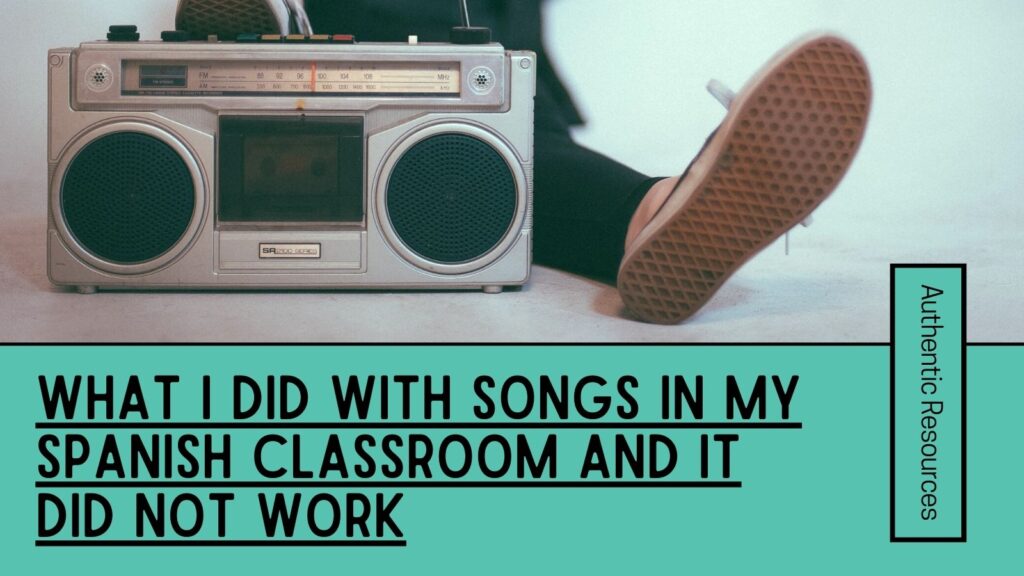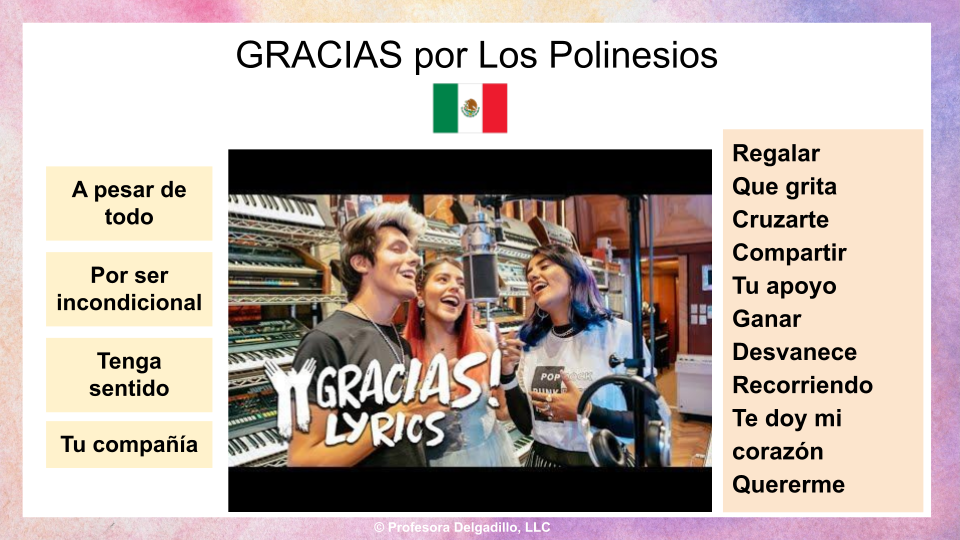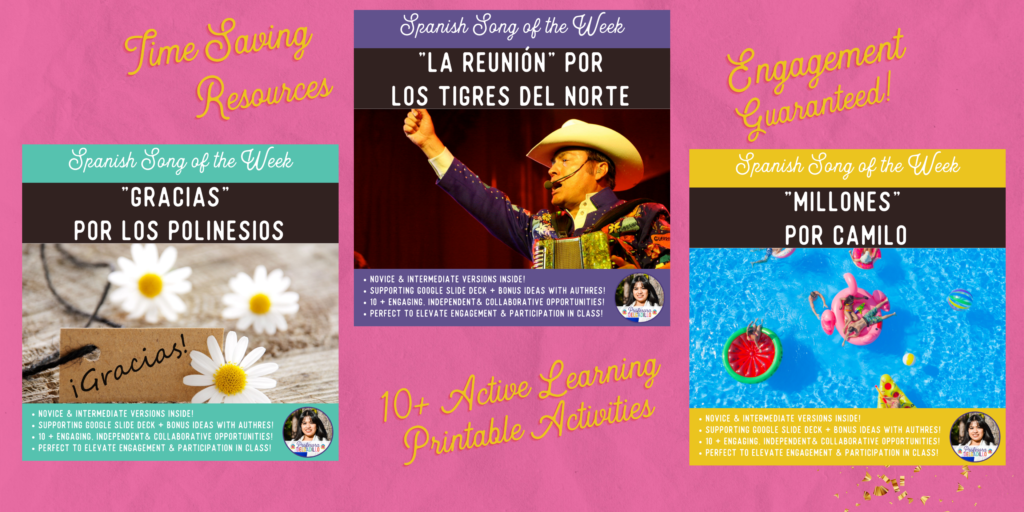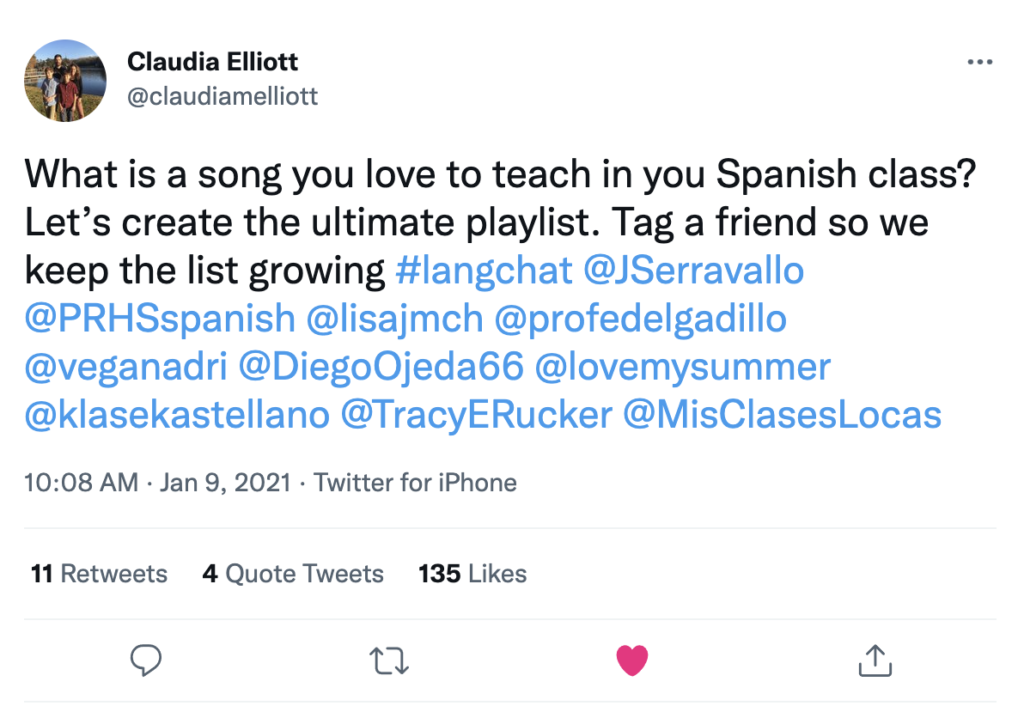In my previous post, I shared about using music lesson plans as authentic resource with songs for Spanish class. Music is life and a universal language in our world language classrooms. If you haven’t read that blog post, please click here!
Today, I am taking a different approach. I am opening my heart to you and sharing some lessons I have learned. These experiences taught me what to avoid when bringing music to my classroom.
Disclaimer: If you do any of these activities and these work for you, keep rocking on! I respect everyone’s individual teaching style.
These Spanish class music activities simply did not work for me over time. It was due to my students’ and program’s needs as well as my teaching style, so I stopped doing them.
I will also offer some thoughts on what you can do instead of these music activities for Spanish class I prefer to avoid.

Mistakes Are Part of Our Formation As WL Teachers
My good friend Meredith White often says “Been there, done that, got the t-shirt,” and I could not agree more when it comes to teaching.
I am referring to the things we have tried in the past all in good faith or sometimes out of desperation. Been there, done that, got the t-shirt.
I am referring to reading about activities, trying them in my classroom only to see them work. When these work, it is great, but when these don’t work we are left wondering 1)Why? 2)What am I doing wrong? or 3)Should I just quit teaching?
There is power in asking yourself that Why? and there is even power in facing the other painful questions. Growth often comes from facing discomfort and searching for solutions. It doesn’t come on our comfort zone.

Things I Stopped Doing with Spanish Music Lesson Plans in My Classroom
1) I NOW AVOID LOOKING FOR SONGS SPECIFICALLY TO TARGET GRAMMAR
In the past, when I used a song to teach a specific grammar structure, I found I wasn’t teaching a beautiful song anymore, I was then solely focusing on grammar.
This often discouraged my learners from truly connecting with the song. It also took away from learners actually adding the song to their music repertoire for enjoyment. I did this so many times.
SO…WHAT CAN YOU DO INSTEAD?
I don’t use this approach anymore to search for music because I have found it is more effective to focus on other things. The focus should be the story from the song (that is in the video or a story we may create as a class). Or even certain parts (not all of it unless the song is short) of the song that have the most profound target phrases (not necessarily grammatical phrases). Instead, I search from songs that are culturally rich, catchy and clean, and/or have strong & valuable messages because even if we don’t hit specific grammar structures, these criteria guarantee our time with a particular Spanish song will be well invested.
2) I STOPPED DRILLING AND KILLING WITH A SONG THAT WAS “DRY”
In the past, I also spent way too much time on a song even when I could see my students hated it.
No one told me, I could pick and choose the activities my classes enjoyed the most. I did not know how to create acquisition driven song activities that could be used over and over again resulting in enjoyable and effective class experiences.
The truth is that sometimes, if we aren’t careful, we can kill the joy of a song because we try to do too much with it. Been there, done that, got the t-shirt.
SO…WHAT CAN YOU DO INSTEAD?
What a better fix than to do than what my friend Claudia Elliott often suggests. It applies to both novels and songs in the world language classroom.
Claudia learned this strategy from Colombian telenovelas. (Yes, who said we can’t find wisdom on novelas?). She says “When the telenovelas aren’t producing good ratings, they are taken out of the programming,” so if a song is flopping, you know what to do. Don’t push it on your students like I did, take it out of the programming, and consider other options.
There are so many beautiful melodies out there from all 21 Spanish speaking countries.
3) I STOPPED LEAVING HIT SONGS BEHIND
I used to allow a successful song to become forgotten because I did not play it or revisit it after I taught with it.
SO…WHAT CAN YOU DO INSTEAD?
- Make a short choreography with your students of the song. If the song has a Tik Tok dance (see video below), even better! Your students will be revisiting the song on their own not only in your class, but also in the hallway and during lunch, which means they will continue to build community outside of your classroom as well.
- Create a class playlist and add the songs you bring to your classroom to this playlist. Then, play the playlist when they are working independently.
- Play La MAESTRA DICE (which I learned from Annabelle Williamson aka La Maestra Loca) with target phrases from the song. Visit Annabelle’s video link.
4) I NOW AVOID SELECTING SONGS BASED ON MY FAVORITE GENRES
I used to play mainly salsa and bachata in class because those were the genres I enjoyed the most. But, by doing so, I limited my students’ exposure to many more beautiful genres out there.
SO…WHAT CAN YOU DO INSTEAD?
- One of the best ways to discover songs is by asking around in a Facebook group for Spanish teachers. Don’t believe me? See for yourself…you will find powerful threads like this one started by Claudia Elliott or this one shared by Abelardo Almazán-Vázquez.
5) I STOPPED BORING THEM TO DEATH TRANSLATING THE ENTIRE SONG FOR THE CLASS
I can’t believe I used to make my students sit through my explanation of the meaning of each line of the song during my first years of teaching. Actually, I don’t know why I thought that was necessary.
I do want to say that I believe it is important for learners to know what they are singing about. So, yes, for engagement and connection purposes I believe it is important to reveal the meaning of the song prior to singing, but we don’t have to explicitly go over its translation line by line.
SO…WHAT CAN YOU DO INSTEAD?
I have found that the way that works best for me and my learners is to have my students put everything away when it is time to sing, and I give them the lyrics in Spanish and English. I also let my learners know that I want them to know everything they are singing about. And, I also invite them to glance over the English lyrics as we sing in Spanish. You can check out how I sing with them in this video.
Activities & Strategies Aren’t Learned Overnight and That is Okay
I hope this blog post has been helpful and has invited you to reflect on acquisition driven music lesson plans in the Spanish classroom.
I will be blogging soon with a list of my favorite podcasts and vlogs about integrating music in the world language classroom.
Talk to you soon!
If you need engaging songs and ready to go music lesson plans for your Spanish classroom, visit the music section of my Tpt store!





One comment